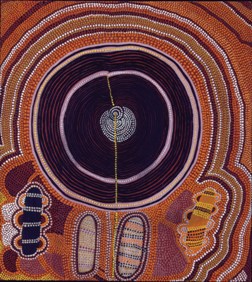Take a look fall exhibitions schedules, and it’s easy to see how the recession has affected museums’ offerings: exhibits are staying in place longer and they are less ambitious than they were a few years ago, for a start. In fact, I think some small shows will provide the most excitement — and I’m not talking about Vermeer’s The Milkmaid, which will go on view at the Metropolitan Museum on Sept. 10.
 Here’s one I’m really eager to see: Icons of The Desert: Early Aboriginal Paintings From Papunya, which opened on Sept. 1 at the Grey Art Gallery of NYU. Organized by the Herbert F. Johnson Museum of Art at Cornell University, it has already been on view there and in Los Angeles.
Here’s one I’m really eager to see: Icons of The Desert: Early Aboriginal Paintings From Papunya, which opened on Sept. 1 at the Grey Art Gallery of NYU. Organized by the Herbert F. Johnson Museum of Art at Cornell University, it has already been on view there and in Los Angeles.
“Early” is a matter of degree: these works were created in the 1970s, after a school teacher gave men from the Central Australian Desert paint, boards and tools and suggested they paint. Curator Roger Benjamin has said the images harken back to ancient mark-making.
The mysterious abstract designs are said to be symbolic.

The exhibit, described more deeply in the Grey’s press release and exhibition website, is the first to focus on these works. (It includes reviews, including this one from the Ithaca Times.) I was also able the see more about the show, and its story, at Amazon, where one can “look inside” the catalogue.
The paintings are all drawn from the collection of John (Cornell PhD, ’70) and Barbara Wilkerson, and have never before been exhibited as a group.
Unfortunately for me, NYU was closed this three-day weekend, and that meant that Grey was not open on Saturday, which was the first day I could have gone downtown to see the show.
Photo Credits: Mystery Sand Mosaic, Shorty Lungkarta Tjungurrayi, 1974 (top); Classic Pintupi Water Dreaming, Shorty Lungkarta Tjungurrayi, 1972, Photo by Tony De Camillo for the
